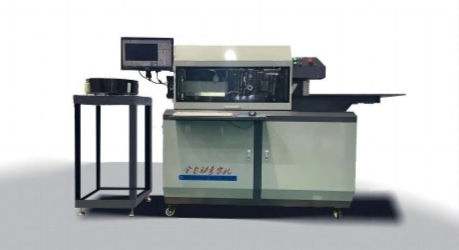How a Letter Bending Machine Works: A Beginner’s Guide
- aokaicnc
- May 7
- 4 min read
Updated: Jul 17

In the world of signage and advertising, precision and speed are everything. That’s where a letter-bending machine steps in. If you’ve ever marveled at those sleek 3D metal letters on storefronts or billboards, there’s a good chance a letter-bending machine was behind the magic. But how exactly does it work? If you're new to the game and wondering how to get started, you're in the right place.
This beginner-friendly guide will break everything down in simple terms so you can understand how these machines transform flat metal strips into beautifully curved letters.
What Is a Letter Bending Machine?
A letter bending machine is a specialized tool used in the signage industry to automatically bend metal strips into custom letter shapes. These machines are often a key part of fabricating 3D channel letters, popular for outdoor advertising and illuminated signage.
Why Is It Important in the Signage Industry?
Let’s face it—manually bending metal into perfect shapes takes serious skill, not to mention time. A letter bending machine makes the process faster, more consistent, and highly accurate. Businesses can produce complex lettering at scale without compromising on quality.
Key Components of a Letter Bending Machine
Understanding how a letter bending machine works means knowing what’s inside. Here are the core components that do all the heavy lifting:
Material Feeder – Feeds the metal strip into the machine.
Straightening System – Removes any bends or warps from the strip before shaping.
Cutting Mechanism – Cuts the metal at precise points.
Bending Unit – This is the heart of the machine. It forms curves and angles.
CNC Control System – A computer interface lets users upload design files and control the machine.
What Materials Can It Handle?
Letter bending machines aren’t one-trick ponies. They’re designed to work with various materials such as:
Aluminum coils
Stainless steel strips
Galvanized sheets
Brass and copper (in some advanced models)
The choice of material often depends on the type of signage you're making and its exposure to the elements.
Step-by-Step: How the Machine Works
Here’s a simplified breakdown of how a letter bending machine operates from start to finish:
Step 1: Design Input
You begin by creating your letter design using vector-based software like Core DRAW or Adobe Illustrator, then convert it into a format the machine understands (usually DXF or PLT).
Step 2: Material Feeding
The metal strip is automatically pulled into the machine. The feeder ensures the material is loaded evenly for consistent results.
Step 3: Straightening
Before bending, the machine passes the strip through a straightener to eliminate natural curves or kinks.
Step 4: Positioning & Cutting
Sensors measure and position the strip precisely. When necessary, the cutter trims the metal to match your letter design.
Step 5: Bending Begins
Now comes the exciting part—bending! The machine uses hydraulic or servo-driven arms to push and pull the metal into the desired shapes, such as curves, corners, or circles.
Step 6: Output
Once the bending is complete, the letter outline is either ejected or moved on for welding and assembly.
Types of Bending Technologies
There are a few different mechanisms used depending on the machine's make and model:
Wheel Bending – Best for smooth, flowing curves.
Hydraulic Bending – Offers power for thicker metals.
Servo Motor Bending – Known for high precision and low noise.
Each type has its strengths, so knowing your business needs can help you pick the right tool.
Common Applications of Letter Bending Machines
These machines are everywhere once you start looking. Here are some places where their work pops up:
Retail storefront signs
Corporate building signage
Backlit LED channel letters
Event branding and exhibitions
Monument signs
If there’s a 3D metal letter somewhere in the wild, chances are a letter-bending machine had a hand in it.
Tips for First-Time Users
If you're just getting started with a letter bending machine, keep these tips in mind:
Start simple – Begin with basic letter shapes before tackling complex scripts.
Use quality materials – Cheap metal can warp, crack, or jam your machine.
Calibrate regularly – Precision is everything; don’t skip machine calibration.
Practice with scrap – Always test with leftover materials before jumping into client work.
Choose the right supplier – Working with a reliable letter bending machine supplier ensures that you receive a high-quality machine and technical support and training, which are crucial when you're just starting.
Maintenance Matters
To keep your machine in top shape:
Clean regularly to prevent buildup of dust and debris.
Lubricate moving parts based on the manufacturer’s instructions.
Update the firmware if your CNC system offers software upgrades.
Inspect blades and rollers for signs of wear and tear.
A well-maintained machine will last longer and produce cleaner, more accurate letters.
Conclusion:
The letter-bending machine has truly revolutionized the signage industry. Whether you're a small business owner just starting or a large manufacturer looking to scale, this tool is a game-changer for precision, efficiency, and professionalism. Understanding how it works helps you make smarter investment decisions and produce better end products.
So next time you see a gorgeous 3D sign lighting up a city street, you'll know what happened behind the scenes. And if you're thinking of diving into the business, there’s never been a better time to bend your way into the future of signage.





Comentarios